December 27, 2010 – 07:35 am EST
‘Twas the week before Christmas, and somewhere in the market
A lonely bear was stirring, eying his pessimistic target.
While the bulls they were waiting by the ticker with care,
In hopes that St. Nicholas would keep prices rising up there.
As luck would have it neither the bulls nor the bears had much to be excited about and Christmas came and went rather quietly. Lets take a closer look at the action (or lack of it)…
.
*****Welcome to all our new readers this week. A Merry Christmas to everyone and thanks for spreading the word!
.
ETF % Change Comparison
.

Once again over the last week we saw SMH, QQQQ and IYT lagging the market. This is a distinct change from the behavior that has characterized the last few months and is an indication that profit taking is highly likely as traders appertite for the more economically sensitive areas is diminishing. On a positive note however the small caps (IWM) continue to perform very strongly.
.
Learn more – ETF % Change Comparison
.
![]()
.
A Look at the Charts
.
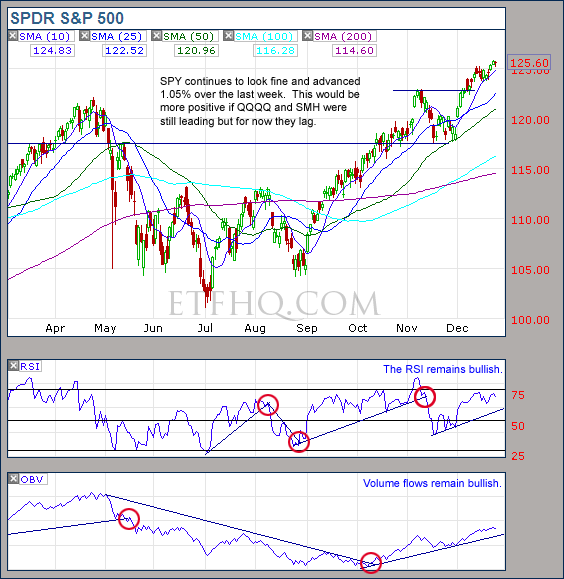
SPY had a good week and continues to look fine (if tired) but no sell signals.
.
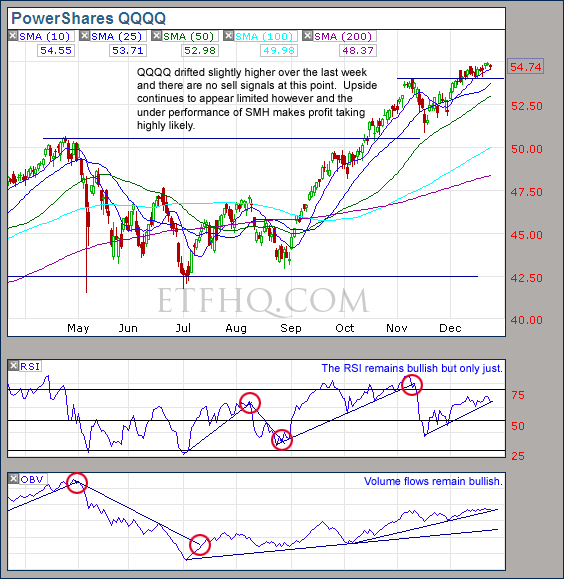
QQQQ is drifting but no sell signals at this stage.
.
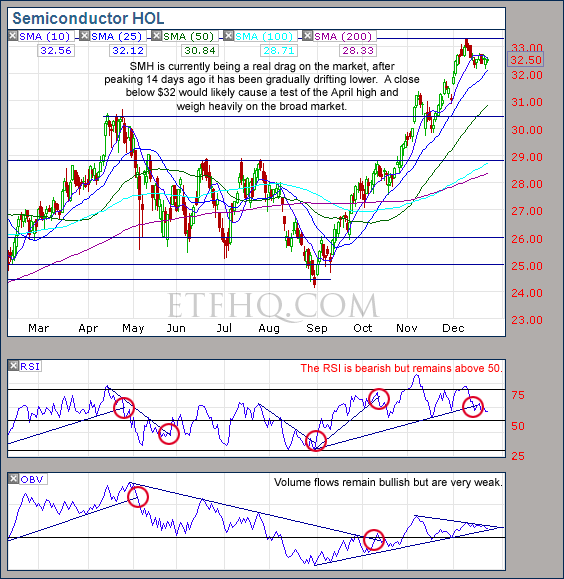
SMH has very weak volume flows, is off its highs and is under performing the broad market. Not a good sign.
.
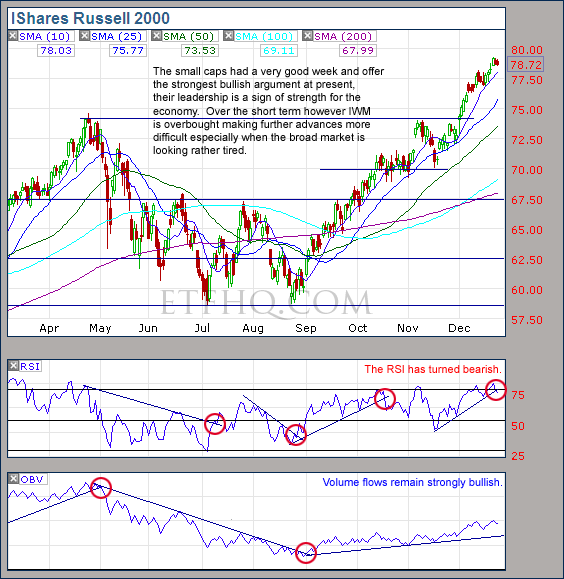
The small caps offer confidence to the bulls with their continued strength.
.
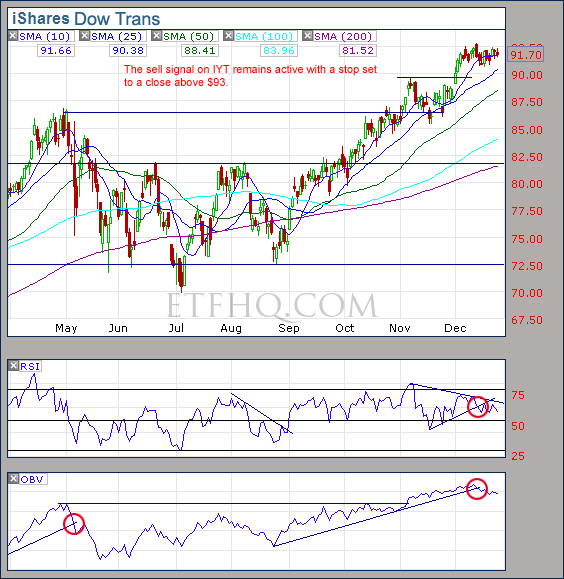
IYT is the only influential ETF on an active sell signal. Will this prove premature? Time will tell.
.
![]()
.
OM3 Weekly Indicator
.

While the buy signals remain active the widespread ‘Bear Alerts’ show that the market cycle is losing strength.
Learn more – The OM3 Indicator
.
![]()
.
TransDow & NasDow
.

Despite our discretionary trading system having the Transports on a sell signal the TransDow continues to maintain an active position in them that is showing a profit of 9.14% after 70 days. The NasDow on the other hand remains in cash as the Dow is still dominant over the NASDAQ.
.
What the TransDow Readings tell us:
The TransDow measures dominance between the DJ Transportation Index (DJTI) and the Dow Jones Industrial Average (DJIA). In a strong market the more economically sensitive Transportation Index should be dominant over the DJIA.
Historically the DJTI has been dominant over the Dow 45% of the time. The annualized rate of return from the DJTI during this period was 18.47% with the biggest loss for one trade sitting at -13.27%. The annualized return from the DJIA during the periods it was dominant over the DJTI was just 4.06% and the biggest loss for one trade was -16.13%. A 4% stop-loss is applied to all trades adjusting positions only at the end of the week.
What the NasDow Readings tell us:
The NasDow measures dominance between the NASDAQ and the DJIA. Using the same theory behind the Trans Dow; in a strong market the more economically sensitive NASDAQ should be dominant over the DJIA.
Historically the NASDAQ has been dominant over the DJIA 44% of the time. Taking only the trades when the NASDAQ is above its 40 week moving average the annualized rate of return was 25.47% with the biggest loss for one trade sitting at –8.59%. The annualized rate on the DJIA during the periods it was dominant over the NASDAQ is just 8.88% and the biggest loss for one trade was –12.28%. A 8% stop-loss is applied to all trades adjusting positions only at the end of the week.
.
![]()
.
LTMF 80 & Liquid Q
.
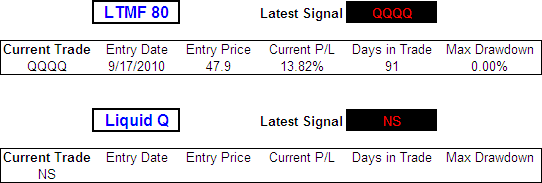
LTMF 80 continues to hold a position in QQQQ that is showing a profit of 13.82% after 91 days. Liquid Q remains in cash.
.
Historical Stats:
.

.
How The LTMF 80 Works
LTMF stands for Long Term Market Forecaster. It reads volume flows relative to price action and looks for out performance of volume measured on a percentage basis over the prior 12 months. During a sustained rally the readings will reach high levels (near 100%) making it imposable for the volume reading to always outperform price so any reading above 80% will maintain the buy signal. This system has outperformed the market over the last 10 years but performance has been damaged by some nasty losses. It only produces buy signals and only for QQQQ.
How Liquid Q Works
Liquid Q completely ignores price action and instead measures the relative flow of money between a selection of economically sensitive and comparatively stable ares of the market. It looks for times when the smart money is confident and and can be seen by through volume investing heavily is more risky areas due to an expectation of expansion. This system has outperformed the market over the last 10 years and remained in cash through most of the major declines. It only produces buy signals and only for QQQQ. We will provide more performance details on the web site for these systems soon.
.
![]()
.
Summary
It was a quiet week and little has changed. What has stayed the same however is the under performance of SMH, QQQQ and IYT which indicates that there is still a good probability of profit taking and that the upside over the short term is likely to be limited.
Any disputes, questions, queries, comments or theories are most welcome in the comments section below.
.
Merry Christmas and enjoy the holidays!!
Derry
And the Team @ ETF HQ
“Equipping you to win on Wall St so that you can reach your financial goals.”
.
![]()
.
Carol of the Day:
These are the carols that I grew up with. I know that Christmas has been and gone but this is just too cheesy and awesome not to share:
.